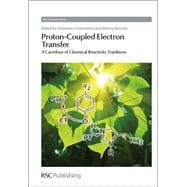
Note: Supplemental materials are not guaranteed with Rental or Used book purchases.
Purchase Benefits
What is included with this book?
| Application of the Marcus Cross Relation to Hydrogen Atom Transfer/Proton-Coupled Electron Transfer Reactions | p. 1 |
| Introduction | p. 1 |
| An Introduction to Marcus Theory | p. 2 |
| Predicting Organic Hydrogen Atom Transfer Rate Constants | p. 5 |
| Obtaining Self-Exchange Rate Constants and Equilibrium Constants | p. 6 |
| Tests of the Cross Relation for Organic HAT Reactions | p. 7 |
| Solvent Effects on HAT Rate and Equilibrium Constants | p. 11 |
| A Test Case: Reactions of Bulky Phenoxyl Radicals with TEMPOH | p. 12 |
| Tests of the Cross Relation using KSE-Corrected Self-Exchange Rate Constants | p. 13 |
| Predicting HAT Rate Constants for Transition Metal Complexes | p. 14 |
| Applying the Cross Relation as a Function of Temperature; the Importance of Using Free Energies | p. 16 |
| Applying the Cross Relation to Oxidations by [RuIV(O)(bpy)2(py)]2+ | p. 17 |
| Precursor and Successor Complexes for HAT | p. 18 |
| Applying the Cross Relation for Transition Metal HAT | p. 20 |
| Transition Metal Systems that Deviate from the Cross Relation | p. 21 |
| Conclusions: Implications and Limitations of the Cross Relation for Hydrogen Atom Transfer Reactions | p. 23 |
| References | p. 27 |
| A Transition-State Perspective of Proton-Coupled Electron Transfers | p. 32 |
| Introduction | p. 32 |
| Theory | p. 34 |
| Hydrogen Atom Transfers | p. 34 |
| Proton Transfers in Hydrogen-Bonded Systems | p. 37 |
| Electron Transfers | p. 40 |
| Concerted Proton-Electron Transfers | p. 47 |
| Applications | p. 48 |
| HAT in the Benzyl/Toluene Self-Exchange | p. 48 |
| PCET in the Phenoxyl/Phenol Self-Exchange | p. 50 |
| CPET in Soybean Lipoxygenase-1 | p. 52 |
| Conclusions | p. 53 |
| References | p. 54 |
| Experimental Approaches Towards Proton-Coupled Electron Transfer Reactions in Biological Redox Systems | p. 57 |
| Introduction | p. 57 |
| Definitions | p. 57 |
| Thermodynamics of PCET Reactions | p. 61 |
| Kinetics of PCET Reactions | p. 64 |
| Experimental Kinetic Approaches to Analyse PCET Reactions | p. 69 |
| Case Studies | p. 73 |
| PCET in Nitrite Reductase | p. 73 |
| Hydride Transfer Reactions in Old Yellow Enzymes | p. 76 |
| Concluding Remarks | p. 79 |
| References | p. 79 |
| Metal Ion-Coupled and Proton-Coupled Electron Transfer in Catalytic Reduction of Dioxygen | p. 89 |
| Introduction | p. 89 |
| PCET from Electron Donors to O2 | p. 91 |
| MCET from Electron Donors to O2 | p. 97 |
| MCET from O2•-Mn+ to p-Benzoquinones | p. 99 |
| Catalytic Two-Electron Reduction of O2 via MCET and PCET | p. 103 |
| Catalytic Four-Electron Reduction of O2 | p. 109 |
| Cofacial Dicobalt Porphyrin and Porphyrin-Corrole Dyads | p. 109 |
| Mononuclear Cu Complexes | p. 115 |
| A Heterodinuclear Indium-Ruthenium Complex | p. 118 |
| Mononuclear Mn Complexes | p. 119 |
| Summary and Conclusions | p. 121 |
| Acknowledgements | p. 121 |
| References | p. 121 |
| Proton-Coupled Electron Transfer in Natural and Artificial Photosynthesis | p. 126 |
| Introduction | p. 126 |
| Proton-Coupled Electron Transfer Reactions | p. 128 |
| Interfacial PCET | p. 129 |
| Thermodynamics of Water Splitting and CO2 Reduction | p. 130 |
| Natural Photosynthesis | p. 132 |
| Structure and Mechanism of Photosystem II | p. 133 |
| PCET in Photosystem II | p. 136 |
| Artificial Photosynthesis | p. 137 |
| Model Systems for Photosystem II | p. 138 |
| Water Oxidation Catalysts | p. 139 |
| Proton and CO2 Reduction | p. 144 |
| Concluding Remarks | p. 145 |
| References | p. 145 |
| Subject Index | p. 152 |
| Table of Contents provided by Ingram. All Rights Reserved. |
The New copy of this book will include any supplemental materials advertised. Please check the title of the book to determine if it should include any access cards, study guides, lab manuals, CDs, etc.
The Used, Rental and eBook copies of this book are not guaranteed to include any supplemental materials. Typically, only the book itself is included. This is true even if the title states it includes any access cards, study guides, lab manuals, CDs, etc.